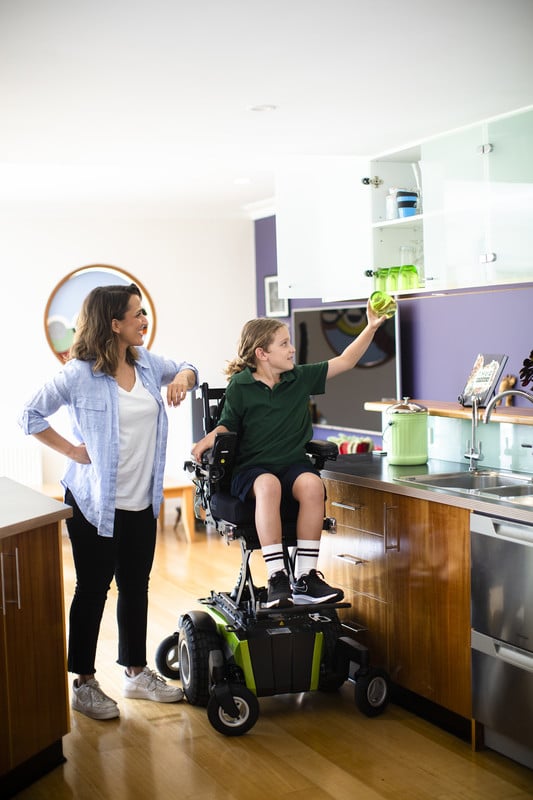
Powered seat elevation has rapidly become the most prescribed powered seat function after tilt-in-space. The benefits of seat elevation are varied, and most users of seat elevation greatly value the increase in independence and function that the feature provides. For some time, seat elevation was viewed as a ‘luxury’ addition to a power wheelchair, but the growing body of clinical evidence is demonstrating that it offers both medical and functional benefits.
Seat elevation is used for a wide variety of reasons. A study completed by in 20081 found that study participants reported accessing seat elevation for the following reasons:
- To reach items at a higher level
- Complete transfers
- Work at different levels
- Shop for items more easily
- Sit at a bar
- Turn on/off light switches
- Go to the bathroom
- Socialise
- Eat
- Read the calendar on the refrigerator
- Reach buttons in the lift
The current clinical evidence has found that powered seat elevation provides:
Improved access to items at varying heights
Several studies have found that wheelchair users use seat elevation to help reach objects at different heights1,2. It is often argued that seat elevation is mainly used for social or non-essential activities, like shopping or ordering a drink at bar, but research has shown that this is not the case. Some of the activities when seat elevation is used to reach items include dressing, grooming, meal preparation, eating, controlling the environment through electrical switches, toileting and bathing2.
Reduced risk of upper limb and back injuries
A study in 2008 investigated the frequency and duration of overhead upper limb activity of wheelchair users and non-wheelchair users who were closely matched in their job activities. The study found that during an 8-hour workday, non-wheelchair users performed an average of 53 occurrences of overhead upper limb activity compared to wheelchair users who performed an average of 297 episodes of overhead upper limb activity3. The study found that the total time spent in an overhead position was five times greater for wheelchair users compared to standing non-wheelchair users3. Considering that it is widely established that repetitive overhead upper limb movements place a person at risk of injury, the study advocates the importance for wheelchair users to minimise potential injury causing positions at the shoulder by avoiding positions such as hand over the shoulder3. Seat elevation can move a wheelchair user into a position where they can reach an item without having to reach upwards, reducing their risk of injury4.
Decreased incidence of neck injuries and discomfort
Most wheelchair users are required to look upwards when interacting with people and the environment, requiring a hyperextended position of the cervical spine. A study in 200413 found that the most comfortable position for wheelchair users tended to be looking straight ahead with the neck slightly flexed, however when required to make eye contact with an average height standing male, cervical spine extension increased to 27°. Sabari and colleagues (2016) echoed the findings of the 2004 study, concluding that there was a statistically significant difference between range of movement requirements to look upwards during tasks or communication for wheelchair users non-wheelchair users, and argued that seat elevation minimises the risk of discomfort and strain injuries at the neck4.
Social benefits of being at eye-level
Research has shown that being at eye-level to your peers can improve socialisation8, help with processing the intentions of communication and contribute to successful non-verbal communication9. There has been a significant amount of research completed showing that eye-contact helps with favourable evaluation of others, while promoting self-esteem and social engagement12. The use of seat elevation can assist wheelchair users during their social interactions.
Functional benefits to being at eye-level
Direct eye-contact has been shown to have a positive impact on memory, stimulate cognition8 and improve interactions with the environment10. When we consider the benefits of seat elevation in relation to being at eye-level, we more often consider the more social aspects discussed above. However one of the most important benefits of being at eye level is functional rather than social. When interacting with an environment at seated height, a wheelchair user must maintain an upward gaze to try and see many items or events in their home and community. In addition to this possibly causing neck and back discomfort, holding an upright gaze is unlikely to be of assistance when trying to see into cupboards, the stove top, access a mirror for personal care tasks or reading information that is secured to a wall (such as air conditioner controls, maps, emergency exit information, menus and calendars)11. Using seat elevation can provide a level line of sight required to complete these activities.
Having a level line of sight in learning environments has also been shown to improve eye contact with media and related education items and has been associated with higher performance in school15.
Increased ability to complete transfers independently and safely
80% of participants in a study from Georgia Tech in 2017 identified that they used seat elevation sometimes or often when transferring to and from their wheelchair2. Completing transfers is usually one of the most strenuous wheelchair activities performed, and can place wheelchair users at risk of developing upper limb injuries5. As clinicians, we often encourage our clients to use heights to their advantage and try to ‘transfer downhill’ when completing sliding or pivot transfers. Usually this involves adjusting the height of a bed to ensure it is higher or lower than the wheelchair or commode being transferred to or from. The application of powered seat elevation can allow a user to be able to ‘transfer downhill’ for all their transfers and therefore reduce their risk of injury. Seat elevation can also make standing transfers less strenuous and demanding6,7.
Improved safety when controlling wheelchair
Using seat elevation to provide a level and horizontal gaze has also been shown to improve interactions with the environment which, in turn, improves safety through obstacle avoidance10. Being at a taller height in some environments through the use of seat elevation allows the wheelchair user to more clearly identify hazards and avoid them, as well as becoming more visible themselves. A review of US accident data established that the low visibility of wheelchair users contributes to the risk of accidents14. The application of seat elevation when interacting with vehicular traffic in high risk situations can make the wheelchair user more visible, and therefore safer, as the user would now be at a similar height to a standing adult.
For clinicians, understanding the clinical evidence regarding seat elevation can help determine whether the feature is reasonable and necessary, and whether it will assist your client to meet their goals. For many power wheelchair users, the application of seat elevation can open their world to new opportunities and greater independence. Determining clear functional and medical goals during the assessment phase will assist in the clinical justification of seat elevation, and your GTK Assistive Technology Consultant can assist during the assessment and trial phase to determine whether seat elevation is the right option for the user. Contact us today for any assistance regarding power seat functions.
References
- Ding, D., Leister, E., Cooper, R.A., Cooper, R., Kelleher, A., Fitzgerald, S. & Boninger, M.L. (2008). Usage of tilt-in-space, recline, and elevation seating functions in natural environment of wheelchair users. Journal of Rehabilitation Research and Development; 45(7), 973-984.
- Rehabilitation Engineering & Applied Research Lab; Georgia Institute of Technology. (2017). Survey of Users of Wheelchair Seat Elevators. Retrieved from http://hdl.handle.net/1853/59106
- Requejo, P.S., Mulroy, S.J., Haubert, L.L, Newsom, C.J., Gronley, J.K., & Perry, J. (2008). Evidence-based strategies to preserve shoulder function in manual wheelchair users with spinal cord injury. Topics in Spinal Cord Injury Rehabilitation, 13(4), 86-119.
- Sabari, J., Shea, M., Chen, L., Laurenceau, A., & Leung, E. (2016). Impact of wheelchair seat height on neck and shoulder range of motion during functional task performance. Assistive Technology, 28(3), 183-189.
- Tsai, C., Hogaboom, N.S., Boninger, M.L., & Koontz, A.M. (2014). The relationship between independent transfer skills and upper limb kinematics in wheelchair Users. BioMedical Research International, DOI: 10.1155/2014/984526.
- Nakamura, K., Nagasawa, Y., Sawaki, S., Yokokawa, Y., & Ohira, M. (2016). Effect of different seat heights during an incremental sit-to-stand exercise test on peak oxygen uptake in young, healthy women. Journal of sports science & medicine, 15(3), 410-416.
- Yoshika, S., Nagano, A., Hay, D.C., & Fukashiro, S., (2014). Peak hip and knee joint movements during a sit-to-stand movement are invariant to the change of seat height within the range of low to normal seat height. BioMedical Engineering Online, 13(27).
- Schreiber, K., & Hausenblas, H. (2016). What eye contact can do for you. Psychology Today. Retrieved from https://www.psychologytoday.com/us/blog/the-truth-about-exercise-addiction/201609/what-eye-contact-can-do-you
- Jiang, J., Borowiak, K., Tudge, L., Otto, C., & Kriegstein, K. (2016) Neural mechanisms of eye contact when listening to another person talking. Social Cognitive and Affective Neuroscience, 12(2), 319–328.
- Diebo, B., Challier, V., Henry, J., Oren, J., Spiegel, M., Vira, S., Lafage, V. (2016). Predicting cervical alignment required to maintain horizontal gaze based on global spinal alignment. Spine, 41(23), 1795-1800.
- Schiappa, V., Piriano, J., Bernhardt, L., Shea, M., Maurer, C., Rosen, L., Lange, M.L., Schmeler, M., Dicianno, B.E. (2019). RESNA position on the application of seat elevation devices for power wheelchair users. Retrieved from https://www.resna.org/Portals/0/Documents/Position%20Papers/RESNA_App%20of%20Seat%20Elevation%20Devices%202019.pdf
- Conty L, George N, & Heitanan J. (2016). Watching eyes effects: When others meet the self. Consciousness and Cognition, 45, 184-197.
- Kirby, R., Fahie, C., Smith, C., Chester, E., & Macleod, D. (2004). Neck discomfort of wheelchair users: effect of neck position. Disability & Rehabilitation, 26(1), 9-15.
- Kraemer, J., & Benton, C. (2015). Disparities in road crash mortality among pedestrians using wheelchairs in the USA: Results of a capture-recapture analysis, BMJ Open, 5:e008396, 1-8. DOI:10.1136/bmjopen-2015-008396
- Volmink L.P. (2015). The role of eye contact in promoting effective learning in natural science in the secondary school. Master Thesis, Department of Education, University of South Africa, November 2015. Retrieved from http://uir.unisa.ac.za/bitstream/handle/10500/20279/dissertation_volmink_lp.pdf?sequen ce=1&isAllowed=y





